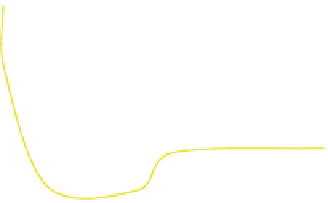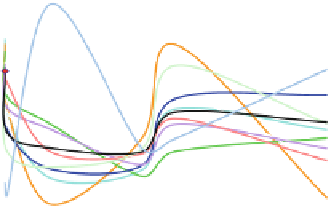Biology Reference
In-Depth Information
Dissipative Structures (Glycolysis)
250
YPL075W
YNL199C
YMR205C
YGL256W
YGL253W
YJL052W
YBR221C
YNL071W
YER178W
YMR083W
YDR081C
YGR193C
YCL040W
200
150
100
50
0
-200
0
200
400
600
800
1000
Time (Minutes)
Fig. 11.6 The time-dependent RNA levels (i.e., RNA trajectories,
ribbons
or RNA waves) of the
glycolytic genes of budding yeast measured with DNA arrays after switching glucose to galactose
at t
¼
0 (Garcia-Martinez et al. 2004). RNA levels were measured in triplicates at six time points;
t
¼
0, 5, 120, 360, 450, and 850 min, and the data points are the averages over the triplicates with
coefficients of variations less than 50%. Of the 13
ribbons
shown in this figure, the ribbon labeled
YCL040W (
light blue
) exhibits an unusual behavior of increasing (rather than decreasing) its
concentration between 5 and 120 min. This is most likely because the transcription of YCL040W
gene is suppressed by glucose under normal physiological condition and the removal of glucose at
t
¼
0 leads to glucose derepression of the gene (DeRisi et al. 1997; Johnston 1999; Ashe et al.
2000; Jona et al 2000; Kuhn et al. 2001)
Genes
are
functions
encoded in static
structures
(e.g., nucleotide sequences) which are
activated into
processes
(e.g., transcription) by molecular
machines
that have been selected
by evolution for their ability to fulfill the needs of the cell under a given environmental
condition. (11.1)
For convenience, Statement 11.1 will be referred to as the
triadic model of the
gene
(TMG) which can be logically derived from combining the concepts and
The concepts of
genotype
and
phenotype
were introduced by Johannsen in 1903
(see Row 4, Table
11.1
). Johannsen was motivated to coin these terms to account
for his finding that genetically identical common beans revealed normally
distributed seed sizes (
http://en.wikipedia.org/wiki/Wilhelm_Johannsen
).
Genotypes are heritable information stored in genes, while phenotypes are the
observable manifestations of genes, on either macroscopic (e.g., morphology,
behavior, biochemical properties of blood) or microscopic (e.g., amino acid
sequences of proteins, RNA trajectories in cells) scale. Referring to Fig.
11.5
,we
can identify genotypes with the Watson-Crick form of genetic information and
phenotypes with the Prigoginian form.
Phenotypes are commonly associated with stable structures such as the shape of
seeds, height of plants, etc., while dissipatons (of which the Prigoginian form of
genetic information is an example) are associated with unstable, dynamic structures























































































































